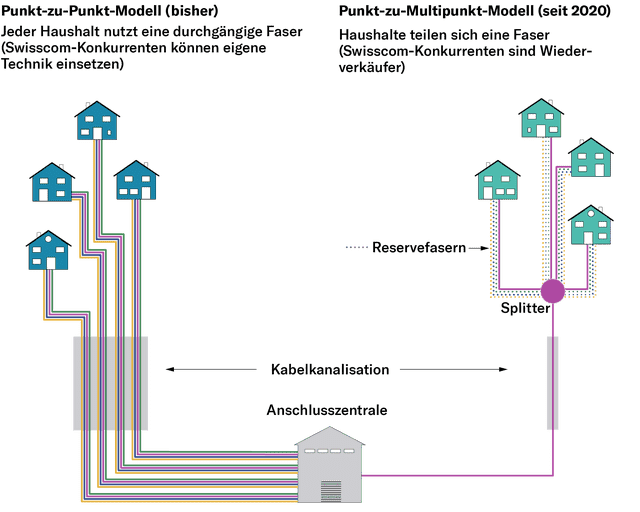Swisscom is turning away from the controversial point-to-multipoint design. The expansion of the fiber optic network is to be carried out “largely” with an architecture that gives the competition watchdogs and small competitors less stomach ache.
It is undisputed that the expansion of fiber optics in Switzerland should be pushed ahead. Parts of the telecom industry are arguing very heatedly about how.
The situation is tricky. Swisscom has built almost 400,000 fiber optic connections that cannot be used by households and companies. Technically everything would be ready, but the telecom group is not allowed to put the connections into operation. The reason: the fiber optic connections are based on the point-to-multipoint architecture. In December 2020, as a precautionary measure, the Competition Commission (Weko) prohibited Swisscom from marketing connections with this type of construction. For a long time, Swisscom seemed to assume that, with a compromise solution in the ComCo main proceedings, it would still be able to use the desired technology within a reasonable period of time. Apparently that has changed.
On Thursday, the telecom group announced that it was “largely” relying on the point-to-point architecture for the expansion of the fiber optic network. In addition, existing connections that are currently blocked will be converted to the (permitted) point-to-point architecture. Depending on your perspective, this is a surrender or a precautionary measure by Swisscom. The telecom company has taken a risk in recent years: despite the precautionary measures taken by Weko, it has continued to build some connections using point-to-multipoint architecture. She was aware that they might never be put into operation due to a later decision by ComCo or the courts in the main proceedings.
According to Swisscom, the change in technology will delay the expansion of the fiber optic network somewhat. By 2025, only 50 to 55 percent of households and companies could be connected to fiber optics. The original 2020 plans called for 60 percent coverage. According to Swisscom, nothing will change in the annual budget for fiber optic expansion: as previously planned, 500 to 600 million are to be invested in this area every year. By 2030, the telecom group is aiming for fiber optic coverage of 70 to 80 percent of households and companies.
What does that mean in concrete terms for the approximately 400,000 households whose fiber optic connection is currently blocked? The unsatisfactory answer is: it depends. By 2025, a little more than half of the connections would be converted, said Swisscom boss Christoph Aeschlimann at a conference call. So tens of thousands will have to wait a few more years. The switch to point-to-point architecture sometimes takes so long because it requires civil engineering work in some places, said Aeschlimann.
In retrospect, the Swisscom boss does not consider this approach to be a mistake, as he said on a conference call on Thursday. The investments in the expansion with the point-to-multipoint architecture are not lost. The reason: the two construction methods do not differ on the last section between the shaft and the household.
Slightly slower expansion
Why is the point-to-multipoint architecture, which Swisscom is now partially abandoning, so controversial? Other Internet providers are dependent on the network of the ex-monopolist. You rent yourself into the Swisscom infrastructure. With the point-to-point construction, Internet providers can use their own technology to illuminate one of the Swisscom fibers. This gives you a lot of leeway when designing the offers. With the point-to-multipoint design, on the other hand, small competitors can no longer use their own technology. They have to be content with a standardized pre-product for which the blue giant provides the technical framework. From Weko’s point of view, there is therefore the suspicion that Swisscom is abusing its dominant market position with the new construction.

